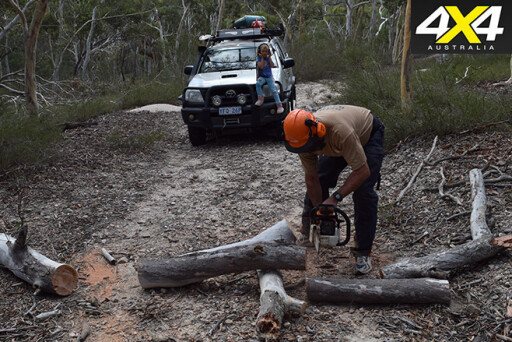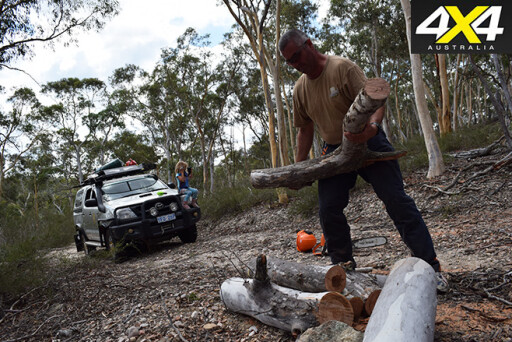
YOU’RE minding your own business driving down a back track when the weather suddenly turns and it starts to blow a gale, which means it’s time to find a safe place to rest. However, around the next bend you’re confronted with a tree lying across the road.
In the back of the vehicle is a chainsaw and personal protective equipment (PPE). Chainsaws often only get used for cutting bits of timber in the backyard, but what do you do when presented with an entire tree on a remote road?
Definitely don’t drive around it, because everyone else will follow suit and before you know it the whole place will be cut up and damaged. After all, it only takes one smart arse to ruin it for the rest of us, and then the track will get closed.
So, how does one clear a track?
 STEP 1: ASSESSMENT
STEP 1: ASSESSMENT
Before starting the chainsaw, stand back and assess the situation – always imagine the worst-case scenario and be prepared for it. Take a few minutes to clear a path behind and to the side for a quick withdrawal.
Think about how to cut each branch and what will happen when you do. Obviously, upward-facing branches will fall, so make sure the fall path is clear.
It’s not so clear what will happen when we cut branches trapped under a fallen tree. In some cases removing them will simply cause the tree to drop; in other cases they will act as a release spring.
Finally, always work with a partner. If you become trapped or injured you’ll have someone to call for help.
 STEP 2: CLEAR THE BRANCHES
STEP 2: CLEAR THE BRANCHES
Start by removing the branches closest to the lower end of the trunk, and then work towards the top of the tree.
Whenever possible, stand on the uphill side of the tree because things roll downhill with gravity.
Work from the left side of the trunk (as you face toward the top of the tree). This allows the safest and most efficient use of the chainsaw, because you can rest the side or bottom of the saw on the trunk and slice off the branches with a pivoting motion.
Cut off branches that are under pressure by first cutting downward through one-third of the branch. Finish the cut by sawing upward to meet the first cut, and always be prepared for the main trunk to roll or drop.
 STEP 3: THE TRUNK
STEP 3: THE TRUNK
Cut trunks that are supported at both ends by making a downward cut one-third the diameter of the trunk.
Cut upward to complete the cut. Finish by cutting up from underneath, and be prepared for one or both sides to drop.
If the trunk is hung up or suspended at both ends, you need to level it – in other words, cut the trunk loose from its stump.
If you attempt to cut straight down through a trunk that’s supported at both ends, the weight of the trunk will pinch the bar and trap your chainsaw.
Stop the engine if the bar does get stuck, then use a thick branch to lever the trunk and open the cut far enough so you can remove the chainsaw.
 STEP 4: FINISH THE JOB
STEP 4: FINISH THE JOB
Technically the offcut branches remain the property of the person who owns the land, so do the owner a favour for letting you on their property. After clearing the route, cut the wood into 30-40cm lengths and leave it in a neat pile by the track.
First, cut three-quarters of the way though, then roll your log over and complete the cuts. This stops the chain hitting the ground.
On government land laws prevent the removal of fallen timber because that might impact on native species. Another reason: some jurisdictions auction such timber; in others, someone might hold a lease for collection. So removing it would be stealing. In some areas you can have your 4x4 and chainsaw confiscated on the spot.
As always, it’s best to check your state’s regulations.
 SAFETY FIRST
SAFETY FIRST
A chainsaw is one of the most versatile tools you can own, but it cuts both wood and flesh equally well. So you need to learn how to safely use this powerful tool. There are a number of accredited courses for those who need WHS certification in the work space, while there are non-accredited courses designed for domestic and farm use. These start at $200 for a one-day course and they cover everything from chainsaw maintenance to how to safely cut fallen trees.

COMMENTS